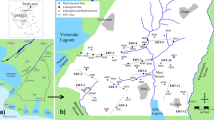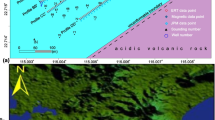Abstract
Karst aquifers are often protected by a thin mantle of unconsolidated sediment. Soil pipes and sinkholes may breach this natural protective barrier and open pathways for contaminants to quickly reach bedrock aquifers. Geophysical surveys offer a quick and noninvasive way to identify these features; such surveys may also be sequenced to reveal increasing detail in critical areas. At a study site in east-central Illinois, electromagnetic (EM) surveys mapped high conductivity anomalies over filled sinkholes and soil pipes that penetrated the unconsolidated cover. Two-dimensional inverted resistivity sections, made over these anomalies, depict filled sinkholes and soil pipes as conductive zones above deeply weathered bedrock fractures. Borings verified the geophysical models and suggest high conductivities associated with the filled sinkholes are the result of enhanced moisture near active soil pipes. EM surveys also identified conductive zones in the overburden above a probable bedrock fracture linking sinkhole areas 0.5 km apart. Resistivity and EM methods, used in a phased and sequential manner, thus proved useful in mapping filled sinkholes and in delineating the vertical and lateral connections between soil pipes and hydraulically active bedrock fractures.









Similar content being viewed by others
References
Ahmed S (2002) Geophysical response of solutionally enlarged bedrock fractures, karst conduits and associated surficial features, Bourbonnais, Illinois. PhD Dissertation, Department of Geology and Environmental Geosciences, Northern Illinois University, DeKalb, IL, 260 pp
Ahmed S, Carpenter PJ, Chen L, Augustine C (1999) Sinkhole and karst conduit identification beneath a natural prairie restoration area in northeastern Illinois. Geol Soc Am Annu Meet Abstr Programs 31:A-144
Aley T (1972) Groundwater contamination from sinkhole dumps. Caves Karst 14:17–23
Batayneh A, Abueladas AA, Moumani KA (2002) Use of ground-penetrating radar for assessment of potential sinkhole conditions: an example from Ghor al Haditha area, Jordan. Environ Geol 41:977–983
Benson RC, La Fountain LJ (1984) Evaluation of subsidence or collapse potential due to subsurface cavities. In: Beck BF (ed) Sinkholes: their geology, engineering and environmental impacts. Proc 1st Multidisciplinary Conf on Sinkholes. Balkema, Boston, pp 201–215
Byers S (1995) Proposal for dedication of Bourbonnais Geological Area in Kankakee County, Illinois, as an Illinois Nature Preserve. Bourbonnais Township Park District and Illinois Nature Preserves Commission Report, Bourbonnais, IL
Carpenter PJ, Doll WE, Kaufmann RD (1998) Geophysical character of buried sinkholes on the Oak Ridge Reservation, Tennessee. J Environ Eng Geophys 3:133-145
Cook KL, Van Nostrand RG (1954) Interpretation of resistivity data over filled sinks. Geophysics 19:761–790
Drew D, Hotzl H (1999) Karst hydrogeology and human activities International Contributions to Hydrogeology No. 20. Balkema, Rotterdam
El-Behiry MG, Hanafy SM (2000) Geophysical surveys to map vertical extension of a sinkhole: a comparison study. In: Powers MH, Ibrahim AB, Cramer L (eds) Proceedings of the Symposium on the Application of geophysics to engineering and environmental problems. Environmental and Engineering Geophysical Society, Wheat Ridge, CO, pp 341–350
Frankie WT (1997) Guide to the geology of Kankakee River State Park area, Kankakee County, Illinois. Illinois State Geological Survey Field Trip Guidebook 1997C, 1998B, Urbana, IL
Kachanoski RG, Gregorjch EG, Van Wesenbeeck IJ (1988) Estimating spatial variations of soil water content using noncontacting electromagnetic induction methods. Can J Soil Sci 68:715–722
Kacaroglu F, Gunay G (1997) Groundwater nitrates pollution in an alluvium aquifer, Eskisehir urban area and its vicinity, Turkey. Environ Geol 31:178–184
Krothe NC, Fei Y (1999) Polychlorinated biphenyl (PCB) contamination of a karst aquifer in an urban environment, central Indiana, USA. In: Chilton J (ed) Groundwater in the urban environment (Selected city profies, 21), pp 171–179
Labuda ZT, Baxter CA (2001) Mapping karst conditions using 2D and 3D resistivity imaging methods. In: Powers M (ed) Proceedings of the Symposium on the Application of geophysics to engineering and environmental problems. Environmental and Engineering Geophysical Society, Wheat Ridge, CO, Paper GTV-1 on CD-ROM
Loke MH (1998) RES2DINV version 3.3: Rapid 2D resistivity and IP inversion using the least-squares method. Computer disk and manual. Penang, Malaysia
McNeill JD (1980) Electromagnetic terrain conductivity measurements at low induction numbers. Geonics, Inc. Technical Note TN-6, Mississauga, Ontario.
Odum JK, Stephenson WJ, Williams RA, Worley DM, Toth DJ, Spechler RM, Pratt TL (1998) Land-based high-resolution seismic reflection image of a karst sinkholes and solution pipe on Fort George Island, Duval County, northeastern Florida. In: Bell RS, Powers MH, Larson T (eds) Proceedings of the Symposium on the Application of geophysics to engineering and environmental problems. Environmental and Engineering Geophysical Society, Wheat Ridge, CO, pp 285–294
Ogilvy R, Meldrum P, Chambers J, Williams G (2002). The use of 3D electrical resistivity tomography to charasterise waste and leachate distribution within a closed landfill, Thriplow, UK, J Environ Eng Geophys 7:11–18
Panno SV, Wiebel CP, Heigold PC, Reed PC (1994) Formation of regolith-collapse sinkholes in southern Illinois: Interpretation and identification of associated buried cavities. Environ Geol 23:214–220
Paschke JE (1979) Soil survey of Kankakee County, Illinois. US Dept of Agriculture, Soil Conservation Service and Illinois Agricultural Experiment Station, Urbana, IL
Peterson EW, Davis RK, Brahana JV, Orndorff HA (2002) Movement of nitrate through regolith covered karst terrane, northwest Arkansas. J Hydrol 256:35–47
Rhoades JD, Raats PAC, Prather RJ (1976) Effects of liquid-phase electrical conductivity, water content, and surface conductivity on bulk soil electrical conductivity. Soil Sci Am J 40:651–655
Roark M, Anderson N, Dillon B, Lippincott T, Drexelius A, Hinds R (1997) A ground-penetrating radar study of karst features in southcentral Missouri. In: Bell RS (ed) Proceedings of the Symposium on the Application of geophysics to environmental and engineering problems. Environmental and Engineering Geophysical Society, Wheat Ridge, CO, pp 559–566
Roth MJS, Mackey JR, Mackey C, Nyquist JE (1999) A case study of the reliability of multi-electrode earth resistivity testing for geotechnical investigations in karst terrains. In: Beck BF, Pettit AJ, Herris JG (eds) Proceedings of the 7th Multidisciplinary Cconference on Sinkholes and the engineering and environmental impacts of karst, Balkema, Rotterdam, pp 247–252
Rozkowski J (1998) Endangering of the Upper Jurassic karst-fissured aquifer in the Krakow Upland (southern Poland). Environ Geol 33:274–278
Steeples DW, Knapp RW, McElwee CD (1986) Seismic reflection investigations of sinkholes beneath Interstate Highway 70 in Kansas. Geophysics 51:295–301
Stewart M, Parker J (1992) Localization and seasonal variation of recharge in a covered karst aquifer system, Florida. Int Contrib Hydrol 13:443–460
Stuart JC, Wilson SD, Barry RC (1990) Regional assessment of the ground-water resources in eastern Kankakee and northern Iroquois counties. Illinois State Water Service, Report of Investigations 111, State of Illinois, Department of Energy and Natural Resources, Urbana, IL
Thompson MD, Miller SF, Glennon MA, Cooper JM (2001) Seismic characterization of the karst bedrock surface in the southeast industrial area at Anniston Army Depot, Alabama. In: Powers M (ed) Proceedings of the Symposium on the Application of geophysics to engineering and environmental problems. Environmental Engineering Geophysical Society, Wheat Ridge, CO, Paper GTV-2 published on CD-ROM
Vaute L, Drogue C, Garrelly L, Ghelfenstein M (1997) Relations between the structure of storage and the transport of chemical compounds in karstic aquifers. J Hydrol 199:221–238
Yuhr L, Benson R, Butler D (1993) Characterization of karst features using electromagnetics and microgravity: a strategic approach. In: Bell RS, Lepper CM (eds) Proceedings of the Symposium on the Application of geophysics to engineering and environmental problems. Environmental and Engineering Geophysical Society, Wheat Ridge, CO, pp 209–228
Zhou W, Beck BF, Stephenson JB (2000) Reliability of dipole-dipole electrical resistivity tomography for defining depth to bedrock in covered karst terranes. Environ Geol 39:760–766
Zhu XY, Xu SH, Zhu JJ, Zhou NQ, Wu, CY (1997) Study on the contamination of fracture-karst water in Boshan District, China. Ground Water 35:538–545
Acknowledgments
The authors would like to thank the Bourbonnais Township Park District, the Northern Illinois University Graduate School and the Department of Geology and Environmental Geosciences for funding this project. James Cooper of Argonne National Laboratory, Chris Augustine, Liang Chen and Rebecca Vershaw of Northern Illinois University provided valuable assistance in collection of field data for this project. Mike Konen of the NIU Geography Department provided valuable assistance in the analysis of soil samples. We would also like to thank an anonymous reviewer for suggestions that greatly improved this manuscript.
Author information
Authors and Affiliations
Corresponding author
Rights and permissions
About this article
Cite this article
Ahmed, S., Carpenter, P.J. Geophysical response of filled sinkholes, soil pipes and associated bedrock fractures in thinly mantled karst, east-central Illinois. Env Geol 44, 705–716 (2003). https://doi.org/10.1007/s00254-003-0812-3
Received:
Accepted:
Published:
Issue Date:
DOI: https://doi.org/10.1007/s00254-003-0812-3




